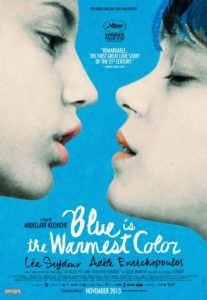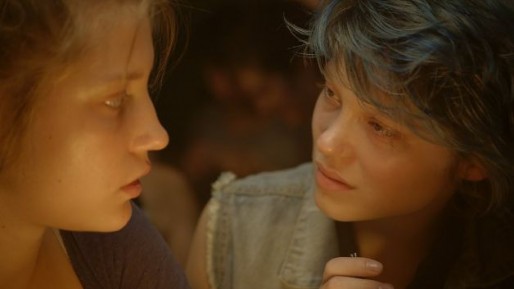An inquisitive high school junior struggles to find her own sexual identity in Blue is the Warmest Color.
Our high school years are rife with lessons to be learned. The biggest, of course, are those learned outside the classroom, and those often include the most vexing challenges of our lives to that point. For those unsure of their own sexuality, the conflict can be all the more troublesome. Such is the case for 17-year-old Adèle (Adèle Exarchopoulos). She’s popular with almost everyone at school and naturally draws the attention of the most desirable boys, but something just doesn’t feel right. She’s excited by the interest but feels anxious at the thought of going any further with it. When she is with the opposite sex, it just doesn’t bring the expected euphoria. Only when she encounters Emma (Léa Seydoux) does everything begin to come into focus. That brief interlude breaks loose her true sexual foundation, driving her to fulfill its call. Regardless of its base correctness, Adèle is still held back by its nonconformity to what she and many of her peers have been raised to accept.
This is, at its best, an incredibly intimate close-up into the heart of a young woman’s sexual awakening. It’s at once both as tender and as vibrant as the petals of a rose in full bloom. The core of its power comes directly from the incredible performances of its two young stars. We rise and fall with every tangible emotion they evoke — each one tugging at its twin in our own inner being. Adèle’s guilt over her situation and the pressure to fit in effectively dig in areas of our psyche that many of us have tried a lifetime to bury. Emma, meanwile, is absolutely captivating with every hypnotic gaze. Adèle is a willing moth drawn effortlessly to her flame. The anticipation between them is continually, sumptuously palpable.
If only a film was judged by the acting alone. Director Abdellatif Kechiche squanders this formidable strength in a number of critical missteps. For starters, the film is three painful hours long. Much of that is due to countless, absurdly drawn-out scenes that are often patently unnecessary. Then there’s his overly exuberant use of close-ups. Some were wonderfully effective, but like anything else, the impact dulls considerably with repetition. Most distracting is his inclusion of blue in every scene like some sort of odd, unnecessary game. Blue hair, blue dress, blue sky, blue fingernails, blue cars. I get it already. Now all I’m feeling is blue about all of the blue.
Then, for a film that loves interminably long scenes, it does a complete 180 regarding several instrumental plot elements that were either cut too short or left out entirely. The worst example of that involves the story jumping ahead three years without any warning. You figure it out, but it’s only after several minutes of needless confusion.
The most talked-about element of the film is its NC-17 rating because of its graphic sex scenes. Make no mistake — this is going to be one hot property on Netflix. That’s fine, but once again, Kechiche seems to have no sense of balance. One surprisingly long session created a clear sense of discomfort throughout the theater. That’s one thing, but when you add in a soapy shower scene, suddenly there’s no way to avoid the verdict of it being gratuitous at best. It was as if we’re watching as Kechiche plays out his own lesbian fantasy with his two main stars.
If all of that wasn’t enough, after three hours of foreplay, we get a wham-bam-thank-you-ma’am ending that’s coldly unsatisfying.
For all its accolades and its powerful performances, I was left thinking its most effective connection to the color blue was the one every teen boy finds out about after being toyed with like this for three hours without satisfaction.




